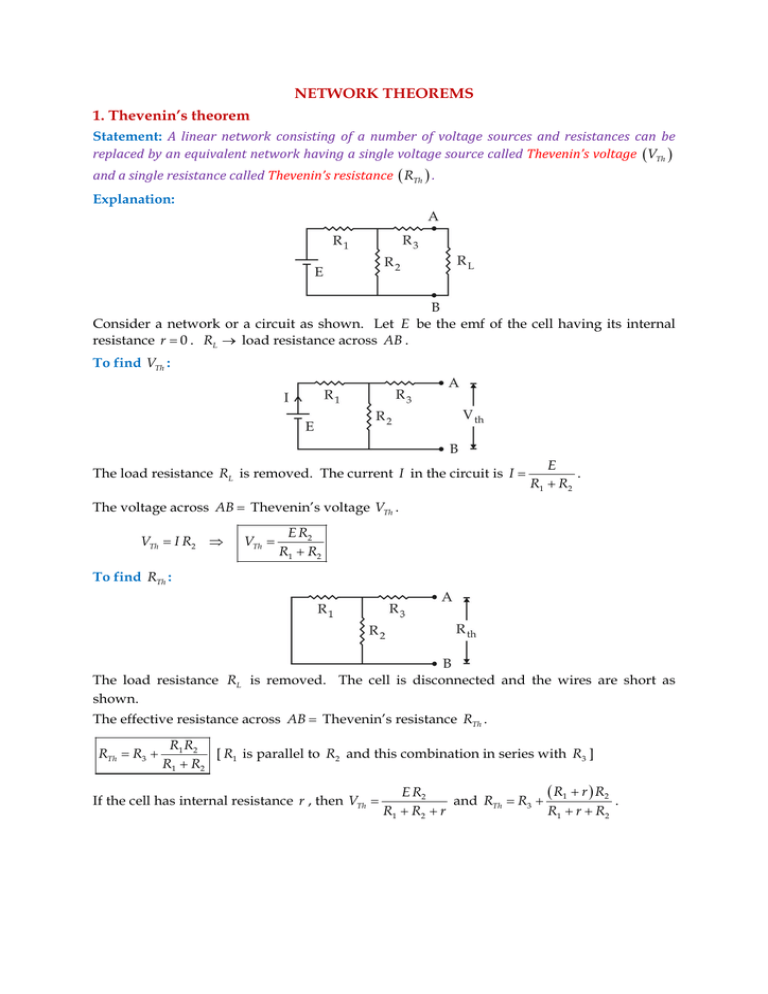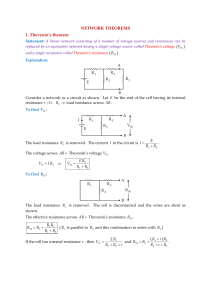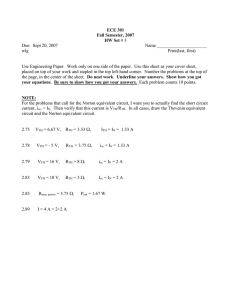NETWORK THEOREMS 1. Thevenin`s theorem
advertisement

NETWORK THEOREMS 1. Thevenin’s theorem Statement: A linear network consisting of a number of voltage sources and resistances can be replaced by an equivalent network having a single voltage source called Thevenin’s voltage (VTh ) and a single resistance called Thevenin’s resistance ( RTh ) . Explanation: Consider a network or a circuit as shown. Let E be the emf of the cell having its internal resistance r = 0 . RL → load resistance across AB . To find VTh : The load resistance RL is removed. The current I in the circuit is I = E . R1 + R2 The voltage across AB = Thevenin’s voltage VTh . VTh = I R2 ⇒ VTh = E R2 R1 + R2 To find RTh : The load resistance RL is removed. The cell is disconnected and the wires are short as shown. The effective resistance across AB = Thevenin’s resistance RTh . RTh = R3 + R1 R2 [ R1 is parallel to R2 and this combination in series with R3 ] R1 + R2 If the cell has internal resistance r , then VTh = E R2 ( R + r ) R2 and RTh = R3 + 1 . R1 + R2 + r R1 + r + R2 NETWORK THEOREMS Proof of Thevenin’s theorem: Consider the network as shown below The equivalent circuit is given by The effective resistance of the network in (1) is R3 and RL in series and this combination is parallel to R2 which in turn is in series with R1 . Thus, Reff = R1 + R2 ( R3 + RL ) -------------- (1) R2 + R3 + RL The current I in the circuit is I = or I = E = Reff E R ( R + RL ) R1 + 2 3 R2 + R3 + RL E ( R2 + R3 + RL ) ----------- (2) R1 R2 + R1 R3 + R1 RL + R2 R3 + R2 RL The current through the load resistance ( I ′ ) is found using branch current method. I′ = I R2 ----------- (3) R2 + R3 + RL Substituting for I from (2) in (3) I′ = E ( R2 + R3 + RL ) R2 ( R2 + R3 + RL )( R1 R2 + R1 R3 + R1 RL + R2 R3 + R2 RL ) or I ′ = ER2 ------------ (4) R1 R2 + R1 R3 + R1 RL + R2 R3 + R2 RL Thevenin’s voltage VTh = ER2 ----------- (5) R1 + R2 Thevenin’s resistance RTh = R3 + R1 R2 ---------- (6) R1 + R2 Consider the equivalent circuit (circuit (2)) The current I ′′ in the equivalent circuit is I ′′ = VIJAYA COLLEGE VTh ----------- (7) RTh + RL Page 2 NETWORK THEOREMS Substituting for VTh and RTh from (5) and (6) in (7) I ′′ = E R2 E R2 1 × = R R +R R +R R +R R +R R R1 + R2 R + R1 R2 + R ( R1 + R2 ) 3 1 3 2 1 L 2 L 1 2 3 L R1 + R2 ( R1 + R2 ) I ′′ = or E R2 ------------- (8) R1 R2 + R1 R3 + R1 RL + R2 R3 + R2 RL From equations (4) and (8), it is observed that I ′ = I ′′ . Hence Thevenin’s theorem is verified. 2. Maximum Power Transfer Theorem Statement: The power transferred by a source to the load resistance in a network is maximum when the load resistance is equal to the internal resistance of the source. Proof of Maximum power transfer theorem: Consider a network with a source of emf E and internal resistance r connected to a load resistance RL . The current I in the circuit is I= E ----------- (1) RL + r 2 E The power delivered to load resistance RL is PL = I 2 RL or PL = RL RL + r (from equation (1)) PL = E2 ( RL + r ) 2 RL ---------- (2) The variation of PL with RL is as shown. PL is found to be maximum for a particular value of RL when dPL PL is maximum, =0 dRL [Q No variation of PL with RL at PL max ] i.e., d E2 RL dRL ( RL + r )2 −3 −2 E2 RL ( −2 ) ( RL + r ) + ( RL + r ) = 0 Differentiating 2 RL ( RL + r ) Thus, 3 = d 2 −2 E RL ( RL + r ) = 0 = 0 or dRL or −2 RL ( RL + r ) 3 + 1 ( RL + r ) 2 =0 or 1 ( RL + r ) 2 RL =1 RL + r 2 ⇒ 2 RL = RL + r or RL = r Thus the power delivered to the load resistance is maximum when the load resistance is equal to the internal resistance of the source. VIJAYA COLLEGE Page 3 NETWORK THEOREMS To show that the maximum power transfer efficiency of a circuit is 50%: The power across the load PL = I 2 RL = E2 ( RL + r ) 2 RL ----------- (1) From the maximum power transfer theorem, PL is maximum when RL = r . Putting this condition in equation (1), PL max = E2 ( 2 RL ) 2 RL ⇒ PL max = E2 ------------- (2) 4 RL The power that is taken from the voltage source is (or power generated by the source), E2 E2 E2 P = I 2 ( RL + r ) = R + r ) or P = . When RL = r , P = -------- (3) 2 ( L RL + r 2 RL ( RL + r ) Dividing equation (2) by (3) PL max P = E2 2 RL 1 P × 2 = or PL max = 4 RL E 2 2 Thus the maximum power delivered to the load is only half the power generated by the source or the maximum power transfer efficiency is 50%. The remaining 50% power is lost across the internal resistance of the source. 3. Superposition theorem Statement: In a linear network having number of voltage or current sources and resistances, the current through any branch of the network is the algebraic sum of the currents due to each of the sources when acting independently. Explanation: By mesh current analysis. 1. Consider the network as shown. The currents in different branches of the network are I 1 , I 2 and I as shown. Also I 1 + I 2 = I . 2. [Let the internal resistance r of the cells be negligible]. The cell E2 is removed and the terminals are short as shown. Now the currents in the branches are I 1′ , I 2′ and I ′ . Also I ′ = I 1′ + I 2′ . VIJAYA COLLEGE Page 4 NETWORK THEOREMS 3. The E1 is removed and the terminals are short as shown. The currents are I 1′′ , I 2′′ and I ′′ . Also I ′′ = I 1′′ + I 2′′ . According to superposition theorem I 1 = I 1′ + I 1′′ . I 2 = I 2′ + I 2′′ and I = I ′ + I ′′ I = I1 + I2 Verification of superposition theorem: 1. Consider the network shown. Applying Kirchhoff’s voltage to the loop 1. [Q I 1 R1 + I ( R3 ) = E1 I 1 R1 + I 1 R3 + I 2 R3 = E1 or I 1 = I = I1 + I2 ] E1 − I 2 R3 ----------- (1) R1 + R3 Considering loop 2, I 2 R2 + I R3 = E2 . I 2 R2 + I 1 R3 + I 2 R3 = E2 I2 = E2 − I 1 R3 ---------- (2) R2 + R3 Thus, I = I 1 + I 2 I= E1 − I 2 R3 E2 − I 1 R3 ----------- (3) + R1 + R3 R2 + R3 2. Consider the circuit shown with E2 removed and terminals short. Applying Kirchhoff’s law to loop 1. I 1′ R1 + I ′R3 = E1 As I ′ = I 1′ + I 2′ , E − I ′R I 1 R1 + I 1′ R3 + I 2′ R3 = E1 ⇒ I 1′ = 1 2 3 ---------- (4) R1 + R3 Similarly for loop 2, I 2′ R2 + I ′R3 = 0 ⇒ I 2′ = − I 2′ R2 + I 1′ R3 + I 2′ R3 = 0 I 1′ R3 ----------- (5) R2 + R3 E − I ′R I ′R I ′ = I 1′ + I 2′ = 1 2 3 − 1 3 …….(6) R1 + R3 R2 + R3 3. Consider the circuit with E1 removed and terminals short. For loop (1) I 1′′ R1 + I ′′R3 = 0 VIJAYA COLLEGE Page 5 NETWORK THEOREMS As I ′′ = I 1′′ + I 2′′ − I 2′′ R3 ⇒ I 1′′ = ------------ (7) R1 + R3 I 1′′ R1 + I 1′′ R3 + I 2′′ R3 = 0 For loop (2) I 2′′ R2 + I ′′R3 = E2 or I 2′′ = ⇒ I 2′′ R2 + I 1′′ R3 + I 2′′ R3 = E2 E2 − I 1′′ R3 ------------- (8) R2 + R3 − I 2′′ R3 E2 − I 1′′ R3 I ′′ = I 1′′ + I 2′′ = + -------------- (9) R1 + R3 R2 + R3 Adding equations (6) and (9) E1 − I 2′ R3 I ′R I ′′ R E − I ′′ R − 1 3 − 2 3 + 2 1 3 R1 + R3 R2 + R3 R1 + R3 R2 + R3 1 1 E − I ′′ R − I ′ R = E1 − I 2′ R3 − I 2′′ R3 + R2 + R3 2 1 3 1 3 R1 + R3 I ′ + I ′′ = I ′ + I ′′ = 1 R1 + R3 ( ) 1 E − R I ′ + I ′′ + 3 2 2 1 R + R 2 3 ( ) E − R I ′ + I ′′ …….(10) 3 1 1 2 Comparing equations (3) and (10) it is observed that I 1 = I 1′ + I 1′′ I 2 = I 2′ + I 2′′ I = I ′ + I ′′ Hence the proof of the theorem. VIJAYA COLLEGE Page 6






